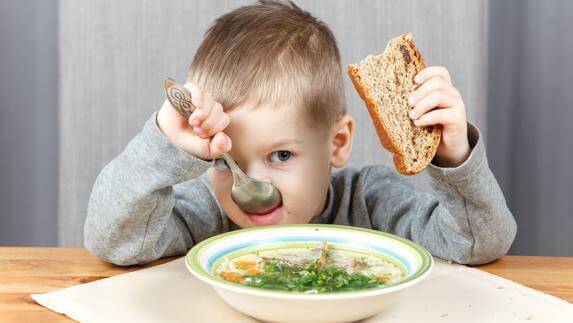Are You Teaching Your Child to Eat Healthy?


Written and verified by the psychologist María Alejandra Castro Arbeláez
Your quality of life is largely determined by your state of health. That’s why it’s so important to encourage children to eat healthy and develop good exercise habits. The key to achieving this is by making good choices for them when it comes to mealtimes.
As adults, one of our most important duties is helping our children eat healthy. Whether or not children view certain foods as healthy or unhealthy depends on the example set by their parents.
Tips for teaching children to eat healthy
If you still don’t know how to teach your child to have good nutritional habits, keep these recommendations in mind:
1. Involve them in the food preparation
Let your children participate in the process of buying ingredients and preparing meals. This way they will become more aware of what they eat.
You can give little ones two healthy options so that they can choose the one they like best. You can also bring them into the kitchen and invite them to prepare very simple recipes.
2. Go to the source of the food
In addition to taking them to the supermarket to check the shelves, bring your child to a local farmers market or farm. The experience of collecting fruit, extracting milk and getting their own food will change their perspective. A good tip that you can put into practice is to have a small garden at home.
3. Prepare healthy snacks
If children find healthy foods in abundance in your kitchen, they will get used to them. Make the foods you want them to eat easily accessible. The best options are pieces of fruit, carrots, crackers and nuts.

4. Remind them to stay well hydrated
In addition to having a solid and balanced diet, it is essential for the body to stay hydrated. Eating healthy also means consuming plenty of water and natural fruit juices or smoothies.
Take every opportunity to introduce your children to equally healthy new foods.
5. Start by modeling good nutritional habits
Your children’s food preferences largely depend on your own. They learn your habits from the womb. When you go out to eat as a family, try to choose more balanced options so that they will do the same in the future. Leading by example is one of the best ways to motivate your child to have a good lifestyle.
6. Be consistent and persistent
Children need to try new foods more than once in order to be attracted to them. If they don’t like a food the first time they try it, look for a different way to prepare or present it. Avoid giving up when children refuse a meal for the first time. Perhaps they will like it better another time.
“The leading cause of death in the world is cardiovascular disease, and this is undoubtedly due to a bad lifestyle. The next is cancer, and it is already well-demonstrated that nutrition also plays an important role in this disease.”
–World Health Organization–
7. Provide reasonable amounts of food
You must take into account your children’s age before putting a full plate on the table. Don’t insist that children eat everything off the plate when you serve them. Just focus on the fact that they eat healthy foods and that they eat enough food to meet their nutritional requirements.
8. Prepare meals at home
Many foods that you buy at the supermarket and at chain restaurants are unhealthy. They contain added sugar and harmful fats that you can avoid by cooking at home. If you don’t have time to prepare food daily, you can cook in advance for several days.

9. Focus on the general diet more than on specific foods
Just because children eat healthy doesn’t mean they can never have a hamburger or hot dog. What matters is that their nutritional base is adequate and that a greater percentage of healthy food is consumed. A dessert or sweet can also be included in the meal plan.
Take care of your health and that of your children and help them become responsible for their own choices. You’ll give them the necessary foundation, but they’ll be the ones who will take care of their health in the future.
All cited sources were thoroughly reviewed by our team to ensure their quality, reliability, currency, and validity. The bibliography of this article was considered reliable and of academic or scientific accuracy.
- G. Hernandez. (2005). Tratado de Nutricion. Tomo III: Nutricion Humana en el Estado de Salud, 2nd ed., Editorial Medica Panamericana SA, Madrid.
- Salas-Salvadó J. (2014). Nutrición y dietética clínica. 3ª ed.Madrid: Elsevier España editorial.
- Ruiz E, Rodríguez P, Valero T, Ávila JM, Aranceta-Bartrina J, Gil A, González Gross M, Ortega RM, Serra-Majem Ll, Vera-Moreiras G. (2017). Dietary Intake of Individual (Free and Intrinsic) Sugars and Food Sources in the Spanish Population: Findings from the ANIBES Study. Nutrients, 2017;9(3):275 https://www.mdpi.com/2072-6643/9/3/275
- Agencia Salud Pública de Cataluña (ASPCAT). (2017) Guía de la alimentación saludable en la etapa escolar. Barcelona.
This text is provided for informational purposes only and does not replace consultation with a professional. If in doubt, consult your specialist.
